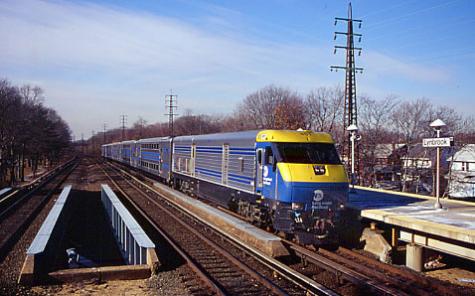Each Monday through Friday, 735 trains carry some 262,000 passengers between Long Island and New York City. In 2004, 80 million trips were taken on the LIRR.
The railroad’s 324-mile network serves 124 stations on 11 routes.
The LIRR is also one of the oldest railroads, having been chartered in 1834. The Pennsylvania Railroad bought the LIRR in 1900, operating it as a subsidiary. With its electrified main lines and direct service to Penn Station, the Long Island Rail Road’s commuter service was heavily patronized…and also costly to operate. The railroad often found itself in bankruptcy. In 1966, the LIRR was sold to the MTA’s predecessor Metropolitan Commuter Transportation Authority.
Under MTA auspices, new equipment was purchased and capital projects were begun. In 1970, electrification was extended east from Mineola to Hicksville on the Main Line, and to Huntington on the Port Jefferson Branch. In 1988, third rail reached another 25 miles east on the Main Line to Ronkonkoma.
The LIRR feeds commuters from nine different branches to four New York City terminals: Pennsylvania Station in Manhattan, Flatbush Avenue in Brooklyn (with subway connections to Wall Street and lower Manhattan), Hunterspoint Avenue in Queens, and Long Island City, also in Queens. The fabled Jamaica station is the busy Queens transfer hub where riders on the various branch lines can change trains to reach any of the four New York City terminals.
Electric trains operate under the East River tunnels into Penn Station, or Flatbush Avenue. Diesel-powered trains serve the two Queens terminals.
Service on electrified lines is provided by a fleet of 1,000 electric M.U. cars. The model M-3 M.U.s (Metropolitans) were manufactured in the 1980s, and in 2003 were joined by the first of what will be 836 M-7 electric M.U.s from Bombardier. (The M-7s will permit retirement of the oldest M.U.s, M-1s built by the Budd Company in the late 1960s and early 1970s.)
Diesel service is provided by General Motors DE30ACs and dual-mode DM30ACs (equipped for diesel-electric operation or third-rail propulsion) delivered in the late 1990s, hauling bilevel coaches from Kawasaki. The LIRR’s Hillside Maintenance Complex is the largest maintenance and repair facility for commuter trains in North America, covering more than 1 million square feet.
Trains operate on all lines seven days a week.
- Port Washington Branch. Electric service to Port Washington, 19.9 miles from Penn Station. The only LIRR line that bypasses Jamaica station.
- Far Rockaway Branch. Electric service to Far Rockaway, 23 miles from Penn Station.
- Long Beach Branch. Electric service to Long Beach, 24.9 miles from Penn Station.
- Hempstead Branch. Electric service to Hempstead, 21.6 miles from Penn Station. Seasonal train service on a branch to the Belmont Park racetrack is also provided.
- West Hempstead Branch. Electric service to West Hempstead, 22.5 miles from Penn Station.
- Oyster Bay Branch. Diesel service to Oyster Bay, 34.7 miles from Penn Station.
- Port Jefferson Branch. Electric service to Huntington, with diesel service operating beyond to Port Jefferson, 59.3 miles from Penn Station.
- Ronkonkoma Branch. Electric service to Ronkonkoma, 50.3 miles from Penn Station.
- Greenport Branch. East of Ronkonkoma, limited diesel service is provided to Greenport, 96.1 miles from Penn Station.
- Babylon Branch. Electric service to Babylon, 38.4 miles from Penn Station.
- Montauk Branch. East of Babylon, diesel-powered trains operate to Patchogue and Montauk, 117.6 miles from Penn Station. During the summer, the LIRR offers reserved parlor-car service on selected Montauk Branch trains serving the Hamptons.














